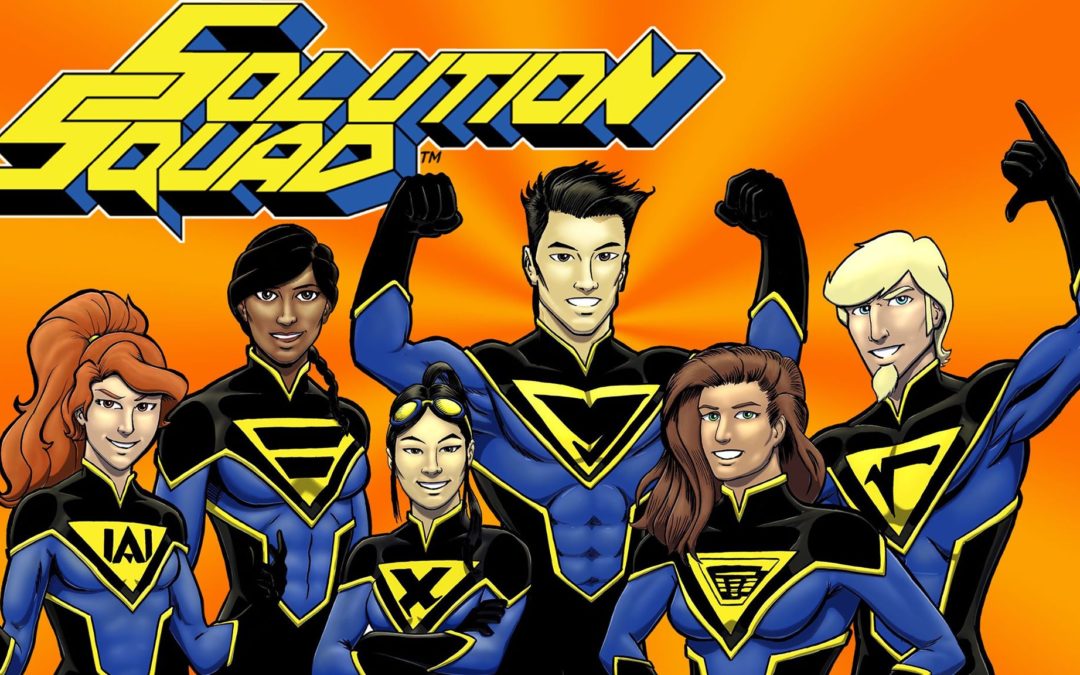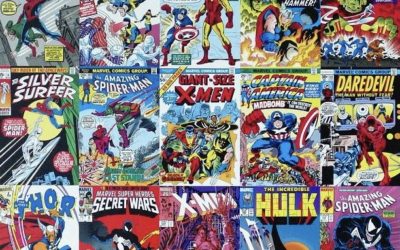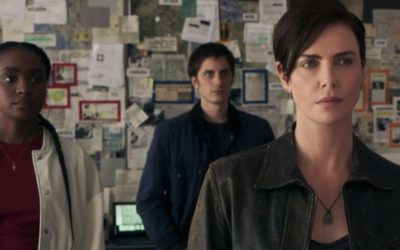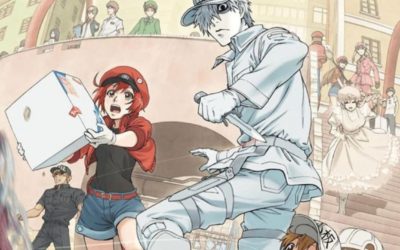Teaching math is an art.
Don’t let anyone tell you otherwise. I did it for 32 years (I recently retired) and I’m here to tell you that if you’re in front of a classroom in the old-fashioned way, the “sage on the stage” as it were, you’d better have a rhythm like a professional standup comic because your subject matter is going to seem dry to the casual learner. But what if you don’t have that talent? What do you use to grab students’ attention if you don’t have snappy patter? Comics. Superheroes are attention-grabbers. They’ve topped the box office for the better part of the last decade or more. More kids these days know Tony Stark than know the name Eratosthenes. It’s time to put Eratosthenes on equal footing.
I didn’t set out originally to create a graphic novel, or even a comic book. I created Solution Squad to be heroes that I could use to replace the Marvel and DC characters I was using on my dozens of classroom activities. I had access to a wide variety of the worksheet sort of stuff early on in my career, and they were so mind-numbingly boring that I tried to jazz them up a little with the superheroes kids were watching on TV and in the movies at the time. The Teen Titans and characters from Smallville and the first X-Men movie figured prominently. But things just kind of took off on me. First, I looked for middle school math comics. That search was unsuccessful. The only book I could find had single-page comics with a few follow up questions after each page. This was the mid-2000s. In early 2007, I read an article that said that just about any subject, save perhaps math, could be taught with comics and graphic novels.
Challenge accepted.
Use characters themselves to embody math concepts.
In Jim McClain’s Solution Squad, my 2017 graphic novel (yes, it took 10 years), the heroes are teenagers with math-themed powers. Absolutia controls temperature, which requires effort whether she raises or lowers it. That very idea is the concept behind absolute value, the distance a number is from zero. LaCalculadora has a mind like lightning and can process information at near-superhuman speeds and never forgets anything. Her specialty is mental math. Equality can duplicate precisely the powers and abilities of any other person. She embodies the concept of equations, with balance on both sides of the equal sign. Abscissa and Ordinate, The Ordered Pair, are twins. Abscissa, born first, can run at hyper speeds along the horizontal axis, while her brother Ordinate, younger by minutes, can fly and dive along the y-axis. Once students learn their stories, they don’t forget the order in which to graph on the coordinate plane. Radical, whose symbol is a square root sign, can create invisible electromagnetic prisms whose bases are right triangles. He can move things, including himself, along the hypotenuse face of such a prism. Every construct he makes is itself an application of the Pythagorean Theorem.

(c) 2020 Jim McClain

(c) 2020 Jim McClain
Numerous studies show that storytelling and narrative help students retain information. When a comic book character embodies a mathematical concept, students are far more interested in the character—at first. But with repeated examples of the Solution Squad characters using their powers, students absorb the ideas, sometimes without even realizing it. I’ve taught using the characters, even before they were in a comic book, for 10 years.
Once they have a handle on the idea of math-themed superpowers, a fun activity to really check their appreciation of the idea comes on Pi Day. I’ve seen lots of Pi Day activities that revolve around making decorations out of the digits of pi, or doing something with pie (the food), but I like to challenge the students to come up with a Solution Squad character based on the concept of pi. I don’t specify whether the character should be a hero or villain, male or female, human, alien, or robot. Their imaginations should be encouraged to explode. Math does not have to be stiff and boring! The conversations among them are wild as they debate whose character is the best.
Direct Instruction
Besides character-based mathematics, the narrative form of comics is very useful for comprehension and retention. In their very first adventure together, the Solution Squad is trapped in a force field by their arch-nemesis, The Poser. The shapeshifting Poser leaves them a clue in the form of a riddle and the Squad has developed a prime number sieve to find the key to the code that will allow them to escape in time to stop the metamorphic menace. The solution to their escape demonstrates teamwork, and just to make things interesting, there’s an activity that allows the students to build the sieve the same way the heroes do in the story. And it doesn’t hurt to throw a little history at them while you’re at it. The answer to the code is “Eratosthenes of Cyrene,” who is the mathematician, scientist, and philosopher who invented the prime number sieve in the first place!
Traditional comics are great. They’re how I learned to read. But in the educational setting, I’ve found that digital comics displayed on a SMART board or a whiteboard using a normal digital projector are more effective. If you’ve ever read one of ComiXology’s guided view comics, the landscape format and new storytelling techniques are engaging. I used them to create a digital version of that first Solution Squad story so that kids can read the speaking parts of the characters like actors in a play. It gives them just that much more buy-in to the story. But if you don’t have access to that technology, reading comics together works just fine, and it’s much less expensive.
Subliminal Math
Here’s how it happens: In one six-panel page of “Primer,” the leader of the Squad, LaCalculadora, sends the twins to recon the area and scout for trouble. She sends Abscissa first,

(c) 2020, Jim McClain
who is back in the blink of an eye, and her sudden burst of speed musses Dora’s luxurious hair. Just as Dora is getting it back under control, Ordinate blasts off into the sky, messing it up again. Abscissa makes a crack about needing a ponytail, and kids just think it’s a lame joke at Dora’s expense and the story continues. After you begin work on graphing on the coordinate plane, hopefully much later, bring this page back to your students. Since they’ve read it previously, they won’t think too much about it. But when you point out the order in which events happen, they will make the connection to the order in which the coordinates are graphed. First x, then y. First horizontal, then vertical. That moment when, months after they’ve met The Ordered Pair, students suddenly catch on that they represent the respective coordinates that they are graphing on the Cartesian plane, they are amazed that they didn’t see it before. The trick is to not beat their heads in with the math concept. Let them come to that realization naturally. They come to know Xiao’s and Yao’s personalities and powers after several stories. When they are as familiar to them as the Avengers, then you drop the concepts on them. It’s powerful.
Of course, there are other comic book resources that you can use to teach math. One that inspired me was The Manga Guide to Calculus, published by No Starch Press. In that book, a fledgling reporter named Noriko is learning the ropes of journalism, and she finds herself quite unprepared to find that mathematics plays an important part in understanding the world in a meaningful way. My highest endorsement comes from the fact that I have a degree in mathematics, and I learned more about calculus from reading this book than I did from taking all of the courses from qualified professors! This is aimed at high school and college, and it’s really good.
Another inspirational title, also about prime numbers, is Gene Luen Yang’s Prime Baby, about a brother trying to relate to a baby sister whom he thinks is an alien because she speaks in repeated “ga” sounds numbered only in primes, much like the aliens contacted Earth in the movie Contact. Originally serialized in the New York Times, this one’s aimed at a younger crowd than my book, but it’s adorable.
The Beast Academy series is also an impressive work. Even though it’s more curriculum than comic, it nevertheless hits a sweet spot for grades 2-5.
A great resource that comes with free downloadable lesson plans is Reading With Pictures: Comics That Make Kids Smarter, published by Andrews McMeel. Intended for grades 3-6, this anthology has four math stories, including an extremely charming one called Finding Ivy, by Michael Bramley and Alice Meichi Lee. In the story, a girl named Ivy is looking for her family and traveling through a world of Roman Numerals. It’s subtle in a way that will appeal to kids. They won’t even know they’re learning when they read it. There’s also a Pokemon parody called Probamon, and there’s even a printable card game that teachers can use to reinforce the probability lessons therein.
This article originally appeared at Pop Culture Classroom. For more information on Solution Squad, head to SolutionSquad.net. Click here to follow and support Jim on Patreon, as well as learn about his other STEM-based work such as Poe and Heroes of STEAM.







